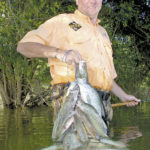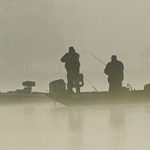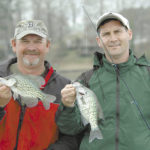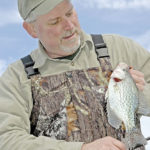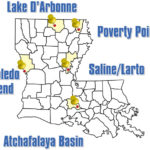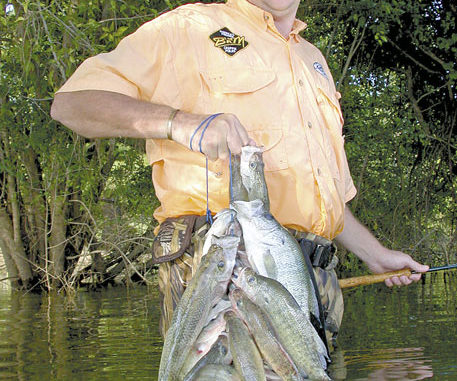
From one side of the state to the other, crappie are eating like animals.
Weather and water levels, temperature and color will determine where you’ll find sac-a-lait this month.
Atchafalaya Basin
When and where you’ll find crappie in the Atchafalaya Basin strictly will depend on the water levels there.
“On rising water this time of year, the crappie will move to the newly-inundated land,” said LDWF biologist Mike Wood. “If you have access to some of those backwater areas, they can provide the best crappie fishing in the Basin.”
Many anglers turn their noses at wade-fishing the Basin from February through May, since critters you may not want to come into contact with live in that shallow water. Wearing chest waders can make you hot, but they also offer some protection from these critters.
“Wade-fish in water above hard ground, instead of soft mud that will suck off your boots,” Wood suggested. “The crappie may be holding in only 1 to 2 feet of water, which means thigh-high waders will work. The springtime crappie are searching for a firm bottom and areas protected from wave action.”
Most wade-fishermen use jig poles, 4- to 6-pound-test line and 1/32- to 1/24-ounce jigs in chartreuse, yellow and/or white to learn which color the crappie like best. They suggest you pull your jig up to the end of the pole, stick the pole into a bush or brushpile and then drop the jig vertically right into the heart of the brush where the crappie concentrate. Later, you easily can wade to that brush and get the crappie out of it.
Ernest Couret Jr. of Lafayette, a second-generation crappie fisherman in the Atchafalaya Basin, said there’s no place he’d rather be at this time of year.
“My father guided in the Basin for 50 years, and I started guiding in 1960 in the afternoons after school and on weekends,” he said. “The fishing in the Basin changes, depending on the river level. During February, the river is usually cold and muddy, and we often don’t enjoy good crappie fishing there until April or May, when the water levels are more stable and the water is more clear.
“When that water starts coming out of the swamp, the fishing can be outstanding. For the last couple of years, the river’s been up 15-16 feet all the way to July.
“I like to fish the river best when it’s about 10 feet and falling. Where you’re fishing in the Basin determines what river level is best to catch crappie. In some areas, 2 feet is ideal for crappie fishing. At other places the best crappie fishing is when the river’s at 3 feet. I fish mostly the Henderson and Bayou Benoit regions.”
Couret primarily fishes with jigs on tight lines — mostly 1/32-ounce jig heads with chartreuse/black or pink/white bodies. But he admits that when the crappie are biting, you can fish with almost any color and catch them. If the water’s clear, he’s fishing 6-pound-test line. But if he starts catching crappie weighing 1 1/2 to 2 pounds each, he’ll change to 12-pound-test line.
During the spring, with two people fishing, Couret will average 60 to 80 crappie on a good day, and on really good days his party will limit out.
“The fish we catch generally will weigh from 1 1/4 to 1 3/4 pounds, and sometimes 2 pounds.”
After the spawn, you can expect the crappie to move out to the centers of the sloughs in the Atchafalaya Basin, and spider-rigging will become much more popular.
Toledo Bend, Lake D’Arbonne
The primary crappie spots in Central Louisiana have spawns occurring at different times, particularly at Toledo Bend.
“The crappie spawn will begin in March and extend well into May in various parts of Toledo Bend,” Wood said.
In February, Wood suggests looking for regions protected from the north wind and indentifying sections of D’Arbonne and Toledo Bend that warm up first in February. Talk to the anglers who fish there to know where the crappie will spawn each month.
“Oftentimes, D’Arbonne and Toledo Bend will have a mixed spawn, with both large and small crappie spawning at the same time,” Wood said. “However, many times the large crappie will come in first to spawn, and then the small crappie may start spawning, followed by a period when only large crappie will spawn. This spawning pattern is quite common at D’Arbonne and Toledo Bend.”
If you’re fishing February through May at these two lakes, one weekend you may load up the cooler with big crappie and only catch small crappie the next weekend.
Bobby Phillips of the Honey Hole Tackle Shop in West Monroe really likes D’Arbonne this time of year.
“D’Arbonne Lake has some of the biggest male crappie I’ve ever caught,” he said.
According to Phillips, the males may come to the bank as early as Feb. 15 or as late as mid-March, depending on the water’s temperature.
“When the water temperature reaches 55 degrees, the male crappie in D’Arbonne will move into about 8 feet of water.” he said. “But once the water warms up to 58 or 60 degrees and stays at that temperature, the crappie will move into the really shallow water about 1/2 to 2 feet deep.”
Phillips mentioned that the crappie spawn on the cypress roots, and he fishes for them strictly with jigs.
“I like a gray, chartreuse and red hair jig 120-Plus R, made by Black Lake Lodge, in a 1/32-ounce, unless the wind’s blowing really hard,” he said. “Then I’ll have to move up to a heavier jig. The crappie aren’t really aggressive at this time of year, and will pick up the jigs and move them off their beds. The crappie will suck the light jigs deeper into their mouths than they will heavier jigs.”
Phillips fishes 20-pound-test Vanish fluorocarbon line and custom-builds his pole, named the Honey Hole. This month, Phillips expects to catch 30 to 50 crappie every time he fishes D’Arbonne, and explains that you can target the suspended female crappie by drift fishing in 8 to 10 feet of water. He’ll fish the scattered stumps by either spider-rigging or fishing with one pole in each hand and drifting.
Saline/Larto
Blake Swallow of Pineville guides on Larto Lake and Toledo Bend. During February, he’ll search for crappie in transition areas on the edges of ledges in 4 to 10 feet of water.
“If the weather’s warm in February, the crappie will be moving closer to the beds, and you should be able to catch them in 6 inches to 2 feet of water at the Saline-Larto complex,” he said. “At Toledo Bend, the crappie will be in grass beds 10- to 14-feet deep, after coming out of 30 feet of water and moving closer to their spawning areas. The spawn’s a little later at Toledo Bend than it is at Saline-Larto.”
On overcast or rainy February days, Swallow fishes a black/chartreuse or purple/white jig. On bright days, he’ll use a pink/white or blue/white jig or possibly a translucent color. He also likes live shiners.
“Larto’s spawn usually begins the first full moon in March and continues until the end of April,” Swallow said. “During a cold front, the crappie will remain in the same area but move to slightly deeper water.
Randy Hulin of Pineville enjoys fishing Saline-Larto Lake in February.
“I’ll be fishing as shallow as 6 inches with jigs, using mid-sized tackle on 8-pound-test line around cypress trees,” he said. “I like a 1/16-ounce jig head, usually in pink, a black/chartreuse, a red/chartreuse or a dark-green/chartreuse grub. If the crappie are shallow and holding around cypress trees, I’ll fish red/white jigs with black heads.
“I wade-fish the bushes this month with 30-pound-test Spiderwire and a jig pole that’s supposed to be 12 feet long that I’ve broken off to 11 1/2 feet. I’m fishing for those big male crappie around the brush and the cypress trees.
“When I’m wade-fishing, I pull my jig all the way up to the end of the pole and then thread it into the bushes. Next I release line and let the jig fall about 6- to 8-inches deep, or until it hits the bottom. Then I’ll pull it up and down off the bottom, using my line to raise and lower my jig and continue to probe various parts of the bush. I’ll put my jig in places that most anglers will never reach.
“These male February crappie will weigh 3/4- to 1-1/2-pounds.”
Hulin invented the Bait Pump, a device that will inject an attractant, like Berkley Crappie Nibbles, into soft-plastic baits like the hollow bodies of the Southern Pro crappie jigs.
“I prefer the chartreuse, glitter-chartreuse, glow-chartreuse and glow-white Berkley Crappie Nibbles in my jigs’ bodies,” he said.
Poverty Point
Although Poverty Point contains loads of big bass and catfish, most people fish for crappie there.
“Wave action is the key to catching crappie at Poverty Point in February,” Wood said. “Locate protected areas that don’t receive much wave action. Wave-break levees have been built in the lake, and you’ll find some near the Poverty Point State Park Marina. However, this area receives a lot of crappie-fishing pressure.”
Wood recommends that you scout more on Poverty Point than you do on some of the other lakes to pinpoint small protected places without much fishing pressure. The state conducted a tagging program recently, and a large number of crappie tagged were recaptured in the marina area.
If you’re fishing North Louisiana after the spawn, Wood recommends fishing the Ouachita River.
“You’ll have a little more current in the river than you find in most lakes, and fishing the mouths of the sloughs can produce good numbers of crappie for the anglers who troll,” he said. “Although the crappie will be out in open water, not holding on the bottom and suspended near bait, they still will be biting.
“Just because the spawn has ended doesn’t mean you stop catching crappie. You may have to fish for them differently than you have during the spawn, but the crappie are still there. If you troll up and down the creek and the river channels, you’ll pull a jig in front of a crappie’s face.
“Depth will be the key to catching crappie after the spawn, and many times you can see both the crappie and the bait they’re feeding on with your electronics. At whatever depth you find the baitfish is the same depth where you’ll locate crappie.”
